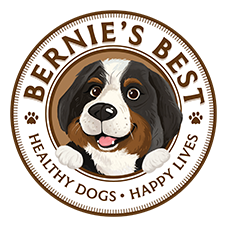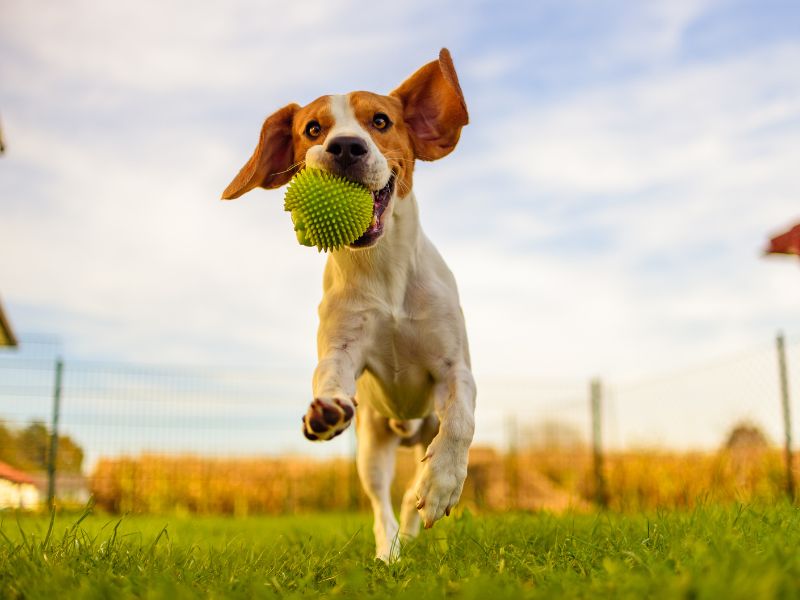Building the Best Joint Health in Young Dogs
Building robust joint health for young dogs is like investing in their future. A strong foundation you build early on can significantly reduce joint-related issues as your best friend ages. There’s a difference between joint health in young dogs and in older ones, and knowing how to build the best joint health in young dogs can be the gift you give them for the rest of their lives!
Understanding Joint Health
Before we look at how to build the best joint health in young dogs, it’s a good idea to look at what we’re trying to avoid for our dogs at any age.
Joint issues in dogs largely fall into two main categories: degenerative and developmental.
Degenerative joint diseases, such as osteoarthritis, involve the progressive deterioration of cartilage in the joints. As cartilage erodes, bones can rub against each other. This leads to pain, inflammation, and decreased mobility. External factors like injury or excessive weight can exacerbate these conditions, but age remains a predominant contributor.
On the other hand, developmental joint issues arise when the joints don’t develop correctly. Hip dysplasia is a prime example, where the hip joint doesn’t fit into the hip socket as it should. This misalignment can cause pain and lead to arthritis over time. Unlike degenerative problems, developmental issues are often hereditary and can manifest in younger dogs. Proper screening, early intervention, and management can mitigate their impact.
- Arthritis: Degenerative joint disease that causes inflammation. While most associate it with older dogs, young dogs can be affected, too. Early onset arthritis may be due to a congenital defect or trauma to the joint.
- Hip Dysplasia: A malformation of the hip joint that leads to abnormal wear and tear, causing pain and arthritis. Genetic and environmental factors play a role. Though common in large breeds, smaller breeds aren’t exempt, nor are young dogs.
The Youth vs. Senior Perspective on Joint Health
 Young dogs are active, with a higher metabolism and energy levels. Their joints are resilient because they’re young, BUT they are also forming and are prone to injury. Purposely paying attention to the joint health of your young dog may help prevent issues as they age.
Young dogs are active, with a higher metabolism and energy levels. Their joints are resilient because they’re young, BUT they are also forming and are prone to injury. Purposely paying attention to the joint health of your young dog may help prevent issues as they age.
Older dogs have wear and tear on their joints. Their slower metabolism means weight gain is a risk factor that can further stress joints. Their care is more about management and comfort.
Exercise for For Dogs by Age
- Puppies: Puppies are like toddlers, curious and full of energy. Good thing they’re cute, too, right?! They need shorter, more frequent play sessions. Activities like gentle tug-of-war, hide-and-seek, or puzzle toys are great. Walks are fabulous for them because they are mentally tired by smelling all the new smells. The more exercise they get, the better the naptime for you!
- Younger Dogs: Active and curious, they need structured play and training. Aim for 30 minutes to two hours daily, depending on the breed. Activities like fetch, agility training, or dog sports can be introduced. They still love their walks and that helps them become familiar with their growing world.
- Senior Dogs: Their exercise should be tailored to their health and stamina. Gentle walks and light play are often sufficient, but also don’t count them out just because they’re seniors! Good preventative care and management can allow them to continue to live their best lives!
Joint-Friendly Exercises for Dogs That Avoid Joint Pain
Some exercises are better for young dogs’ joint health than others. The goal is to remember that when building joint health for young dogs, you’re looking to do it in the best way for their developing bodies and brains. The following exercises are some great options:
- Structured Playtime: Fetch, hide and seek, or even scent games engages their body and mind.
- Swimming: Provides resistance and cardiovascular benefits without straining joints.
- Agility Training: Builds their confidence, focus, and joint health. Start slow and always ensure safety.
- Nature Walks: Different terrains can stimulate their senses and gently exercise joints.
Dos and Don’ts for Puppies and their Growth Plates
A puppy’s growth plate is also known as the epiphyseal plate,and plays a crucial role in its development. Here’s what sets it apart and how it impacts joint health:
Understanding Your Puppy’s Growth Plate
The growth plate is a soft area located at the ends of the long bones in puppies and young dogs. It’s made up of cartilage, which, over time, calcifies or hardens into solid bone. As your puppy grows, this cartilage divides and multiplies, pushing the ends of the bones away from the center, leading to the bone’s lengthening and growth. Once your dog reaches maturity, these growth plates close and harden into solid bone; this indicates that the bones have achieved their full growth.
Growth Plate and Joint Health
- Vulnerability: Since the growth plate is softer than bone, it’s more susceptible to injury. Fractures in this region can interfere with the bone’s ability to grow normally. Such injuries can result in shorter or crooked limbs, which can subsequently affect the dog’s joint health by causing abnormal joint alignment and function.
- Joint Development: Proper closure of the growth plates is essential for the joints’ normal development. Any disruption, whether due to injury, diet, genetics, or other factors, can lead to joint problems, including early-onset arthritis.
- Exercise and Activity Considerations: Given the sensitivity of the growth plate, it’s crucial to ensure puppies aren’t subjected to strenuous activities or high-impact exercises, which can increase the risk of injury to these plates. Activities like jumping from heights or persistent rough play should be minimized. Gentle exercises and controlled play, on the other hand, can help support healthy bone and joint development without placing undue stress on the growth plates. Hard as it may be, remember they’re still growing, and what happens in this time is important to their adult healthy cartilage production.
Dos:
- Safe Play: Opt for soft toys and avoid hard surfaces.
- Supervised Interactions: Ensure play with other dogs isn’t too rough.
Don’ts:
- Avoid High-impact Activities: Don’t encourage jumping from heights or intense roughhousing.
- Avoid Trampolines: Their unpredictable nature can lead to injuries and the impact isn’t good for their growth plate.
Why is Building Joint Health in Young Dogs Crucial?
 Starting early is crucial when it comes to ensuring our furry best friends’ long-term health and vitality. Just like in humans, the foundation for strong joint health in dogs is laid during their younger years. For young dogs, prioritizing joint health can mean the difference between a life filled with active play and one full of joint pain and mobility challenges. It’s an exciting time, though, in caring for our dogs, because there’s a new era of science paving the way for better joint care.
Starting early is crucial when it comes to ensuring our furry best friends’ long-term health and vitality. Just like in humans, the foundation for strong joint health in dogs is laid during their younger years. For young dogs, prioritizing joint health can mean the difference between a life filled with active play and one full of joint pain and mobility challenges. It’s an exciting time, though, in caring for our dogs, because there’s a new era of science paving the way for better joint care.
Prevention Over Cure: Addressing joint health early in a dog’s life can ward off issues before they begin. It’s kind of like building a sturdy house; a strong foundation makes sure that the structure remains stable for years and years. By focusing on joint health in puppies and young dogs, pet parents can reduce the risk of their pets developing joint issues like arthritis or hip dysplasia in their later years.
Promotion of Longevity and Quality of Life: A dog with healthy joints can lead an active and fulfilling life. They can run, play, and interact without the burden of joint pain. This increases their life span and greatly enhances the quality of their years with you.
Nutrition and Gut Health: The Cornerstones of The Best Joint Health
While many of the conventional joint supplements like glucosamine and chondroitin have been widely promoted, more and more, they’re now seen as old science. Today, the emphasis is on holistic health, with a significant focus on nutrition, gut health, and nutrient absorption.
Good gut health ensures that the nutrients crucial for joint health are effectively absorbed. Without a healthy gut, even the best nutrients can go to waste. This is where modern ingredients come into the picture. Here’s a closer look at some of our favorites:
- Blueberry Powder: A powerhouse of antioxidants that combat oxidative stress, potentially reducing joint inflammation.
- Green Tea Extract: Known for its anti-inflammatory properties, it can aid in reducing joint discomfort.
- Turmeric Extract: This is a well-known anti-inflammatory agent that promotes overall joint health.
- Yucca Schidigera: Traditionally used to treat arthritis symptoms, it has properties that help reduce joint inflammation.
- Black Pepper Extract: Boosts the absorption of other nutrients, especially turmeric, amplifying their effects.
- Astaxanthin: A potent antioxidant, astaxanthin helps combat oxidative stress, potentially slowing down the progression of joint issues and inflammation.
- Undenatured Type-II Collagen: This plays a crucial role in the structural integrity of the joints. It can potentially reduce joint discomfort and improve flexibility.
- Virgin Flaxseed Oil (120 mg) & Anchovy Oil: Both sources of omega-3 fatty acids, these oils have anti-inflammatory properties, which can help reduce joint inflammation.
- VermarisⓇ EPA + DHA & Algal Oil: As sources of essential fatty acids, they offer anti-inflammatory benefits and support the lubrication and overall health of the joints.
- Green-Lipped Mussel: Rich in omega-3 fatty acids and other joint-supporting nutrients, this ingredient can aid in reducing joint inflammation and discomfort.
- Kelp Powder & Vitamin C: Kelp is a mineral-rich ingredient and, combined with Vitamin C, can support collagen synthesis, essential for joint health.
Nutrition and Recipes for Joint Health In Young Dogs and Old
Since nutrition plays a pivotal role in joint health for young dogs, it’s fun to give your dog treats that include incredible ingredients. For instance, ingredients like Turmeric, Green Tea Extract, and Blueberry Powder have anti-inflammatory properties and are good for dogs of any age. Consider these treat recipes if you want a bonding experience for you and your best friend.
- Turmeric and Blueberry Bites:
- Ingredients:
- 1 cup oat flour
- ½ cup blueberry powder
- 2 tsp turmeric extract
- 1 egg
- 2 tbsp honey
- Directions: Mix ingredients, form into small balls, and bake at 350°F for 15 minutes. Delicious, sweet treats.
- Ingredients:
- Green Tea and Apple Cookies:
- Ingredients:
- 1 ½ cups rice flour
- 1 tbsp green tea extract (decaf.)
- 2 medium apples, finely grated
- 1 egg
- Directions: Mix ingredients, roll out, use a cookie cutter, and bake at 350°F for 20 minutes. Keep in an air-fresh container for doggie delight!
- Ingredients:
Gut Health and Its Profound Impact on Joint Issues in Dogs
Ensuring optimal gut health in young dogs is the cornerstone for their overall well-being, and this greatly extends to joint health. Their gut, often called the “second brain,” is central to various physiological processes, playing a vital role in immunity, nutrient absorption, and inflammation management. These are factors that are intrinsically tied to the development and maintenance of joint health in young dogs and old.
Your dog’s gastrointestinal system is responsible for breaking down food, absorbing nutrients, and getting rid of waste. The absorbed nutrients, such as proteins, fats, vitamins, and minerals, are pivotal for the growth and repair of all body tissues, including those that make up joint structures like cartilage and bone. When a dog’s gut health is in peak condition, nutrients that support joint integrity, such as calcium, phosphorus, and omega-3 fatty acids, are efficiently absorbed and utilized, laying down the foundation for sturdy and resilient joints. In puppies, this is an excellent foundation for the best adult dog joint health.
The Gut-Joint Axis: Deciphering the Connection
What science is proving to be really fascinating is the dog gut-joint axis. It reveals how a healthy gut can be a potent ally against joint issues in young dogs and in the prospective future joint health of a dog. A balanced gut microbiome rich in beneficial bacteria helps effectively manage inflammatory responses throughout their body. Inflammation is critical in various joint issues, including arthritis and other degenerative joint diseases. When the gut microbiome is balanced, it helps modulate inflammatory responses. This is how it may indirectly protect the joints from excessive inflammation and its damaging effects.
Additionally, a healthy gut can support optimal body weight by aiding in the efficient breakdown and absorption of nutrients. Maintaining an ideal body weight is super important for joint health, especially for young, growing dogs. Excessive weight can place undue stress on their joints. This can predispose them to issues like hip dysplasia and early-onset arthritis.
The Future of Joint Health Lies in the Gut
Paying attention to gut health is not only about facilitating optimal digestion and absorption, but it’s also about proactively protecting our dogs against future joint problems. Implementing a nutritionally rich diet that includes quality fibers, pre- and probiotics and digestive enzymes is the first and best step in building joint health in young dogs. Making sure they are not exposed to undue stress and exercises is key in supporting their gut health and their joints. With a healthy gut, young dogs are better equipped to absorb and utilize nutrients vital for their joint development and are in a better position to manage inflammation effectively. This can greatly reduce the risk of developing joint issues in the future!
When we embrace a holistic approach to our dogs’ health, we encompass all aspects of their well-being. Focusing on their gut health to promote the best joint health for young dogs is an investment in their future. This is how we can help make sure they live their best lives–happy and pain-free. Building joint health in young dogs is not just about avoiding pain; it’s about offering them a quality of life for the future.
And who doesn’t want countless moments of joy, play, and companionship with their best friends?


